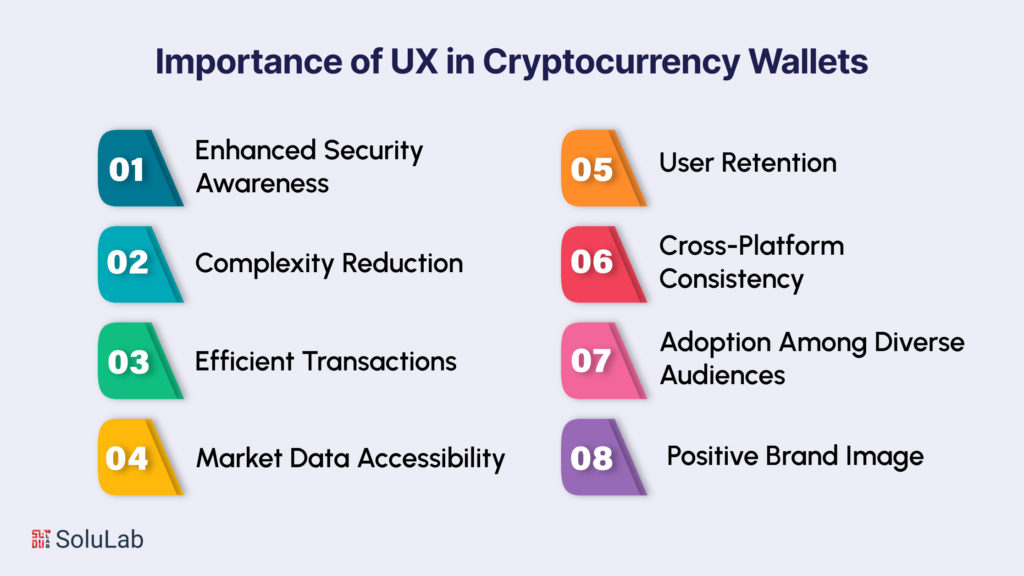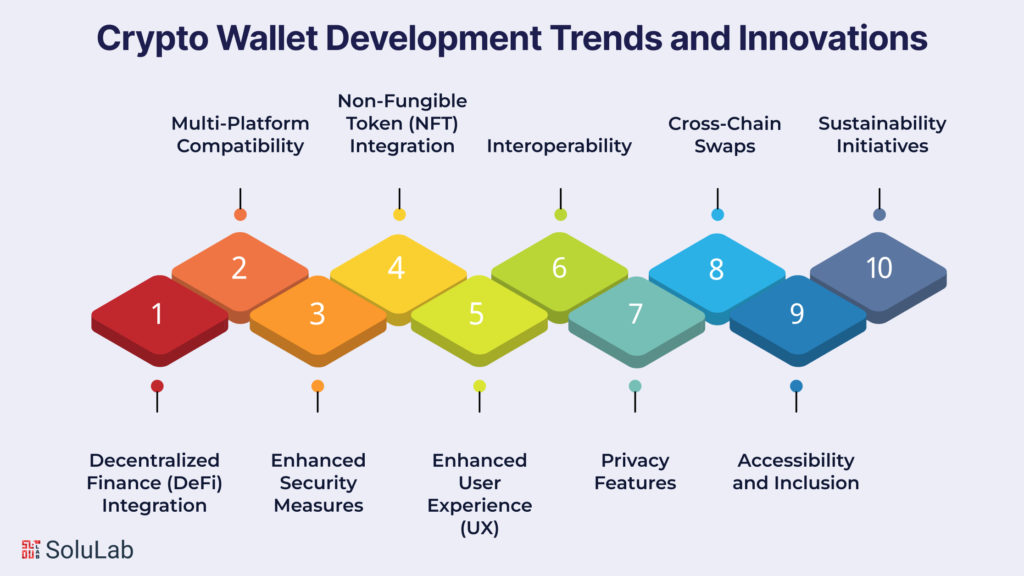
Cryptocurrencies are establishing themselves as a disruptive force in the financial environment due to the availability of secure, decentralized digital assets with a chance to totally transform a number of sectors. At the heart of this digital revolution are the crypto wallets, a piece of software that allows users to securely store, manage, and spend their cryptocurrency in transactions.
As the use of cryptocurrencies grows, new and intriguing advancements in crypto wallets that will enhance security, and user experience, and bring up fresh opportunities are on the horizon. In this blog, we’ll look at the trends and innovations that will influence the rise of crypto wallet development in the future.
So, let’s get started!
Have a Look at Our Blog: How to Buy Real Estate Using Cryptocurrency?
What are Cryptocurrency Wallets?
A cryptocurrency wallet is a digital tool or software application that allows individuals to securely store, manage, and interact with their cryptocurrencies. It stores the private keys necessary to access and control one’s digital assets on a blockchain network. Cryptocurrency wallets enable users to send, receive, and monitor their cryptocurrency holdings, providing a user-friendly interface to interact with the decentralized blockchain technology underlying cryptocurrencies. These wallets come in various forms, including software wallets (online, desktop, or mobile), hardware wallets (physical devices), and paper wallets (physical documents with key information). The choice of wallet type depends on factors such as security preferences and ease of use for the individual user.
Importance of UX in Cryptocurrency Wallets

User Experience (UX) in cryptocurrency wallets plays a pivotal role in the success and adoption of these digital tools. As the crypto landscape continues to expand, the importance of providing a seamless and intuitive user interface (UI) becomes increasingly evident. Let’s explore why UX improvement is paramount in the world of crypto.
- Enhanced Security Awareness: One of the critical aspects of using cryptocurrency wallets is security. Users need to feel confident that their digital assets are safe from theft or hacking. An intuitive UI with clear security features not only helps users understand the safety measures in place but also encourages them to take necessary precautions. Improved UX in crypto wallets ensures that users can easily manage security settings and feel in control of their assets.
- Complexity Reduction: The world of cryptocurrency can be intimidating for newcomers. A user-friendly UI simplifies the complexities associated with crypto, making it accessible to a wider audience. When users can navigate a wallet without confusion, they are more likely to engage with cryptocurrencies, contributing to broader adoption.
- Efficient Transactions: Smooth and efficient user experiences in crypto wallets are pivotal for transaction execution. A well-designed UI streamlines the process of sending, receiving, and monitoring cryptocurrency transactions. This efficiency not only saves users time but also reduces the likelihood of errors.
- Market Data Accessibility: Many cryptocurrency wallets provide users with real-time market data, including price charts and portfolio performance. A good UX ensures that users can access and interpret this data effortlessly. This empowers them to make informed decisions regarding their crypto investments.
- User Retention: In the highly competitive crypto wallet landscape, user retention is crucial. A positive UX encourages users to stick with a particular wallet, fostering loyalty and trust. It’s not just about attracting new users but also about keeping existing ones satisfied.
- Cross-Platform Consistency: As users engage with cryptocurrency across various devices, a consistent UX is essential. Whether using a mobile app, a web-based wallet, or a desktop client, users should find familiar and coherent interfaces. Cross-platform consistency enhances the overall user experience.
Read Also: 4 Big Problems to Solve in Crypto
- Adoption Among Diverse Audiences: Cryptocurrency is no longer the domain of tech-savvy individuals. To achieve mainstream adoption, wallets must cater to diverse audiences, including those who may not be well-versed in blockchain technology. A user-friendly UI accommodates a wide range of users, from beginners to experts.
- Positive Brand Image: Finally, the user interface and overall UX of a cryptocurrency wallet contribute to the wallet provider’s brand image. A well-designed and user-centric wallet can enhance the reputation of the provider, fostering trust and credibility in the crypto community.
Overall, the User Experience (UX) and user interface are more than just aesthetics; they are a critical factor that determines the success and widespread adoption of cryptocurrency wallets. As the crypto space continues to evolve, wallet providers must prioritize UX improvement to simplify the user journey, enhance security, and make cryptocurrency accessible to a global audience. A positive and intuitive user interface not only attracts users but also keeps them engaged, ultimately contributing to the growth of the crypto ecosystem.
Building a Secure Future with Crypto Wallet Development

The necessity of safe and user-friendly cryptocurrency wallets in the ever-expanding world of cryptocurrency cannot be emphasized. Developers are working relentlessly to improve cryptocurrency wallet security, usability, and usefulness in crypto wallets, which has become an important element of the business. Let’s take a deeper look at the trends and innovations influencing the future of the crypto community.
Decentralized Finance (DeFi) Integration
Decentralized Finance, or DeFi, has been a transformative force in cryptocurrency investment, offering users the ability to participate in various financial activities, such as lending, borrowing, yield farming, and decentralized exchange, without relying on traditional financial intermediaries. Wallet providers are recognizing the growing popularity of DeFi and are integrating these functionalities into their platforms to enhance the cryptocurrency investment experience.
- DeFi Dashboards: Cryptocurrency wallets with DeFi integration often feature dedicated DeFi dashboards. These dashboards provide users with a consolidated view of their DeFi holdings, including assets deposited in liquidity pools, yield farming strategies, and decentralized loans.
- Staking and Governance: Many wallets now allow users to stake their crypto assets directly within the wallet’s interface. Users can also participate in on-chain governance processes, such as voting on proposals for DeFi protocols, making cryptocurrency investment more interactive.
- DeFi Yield Tracking: Wallets with DeFi integration offer users real-time information on their DeFi investments’ performance, including current yields and historical data. This feature empowers users to make informed decisions about managing their cryptocurrency investments within the DeFi ecosystem.
Multi-Platform Compatibility
Multi-platform compatibility is essential for users who want to access their cryptocurrency investments and engage in cryptocurrency exchanges across various devices and interfaces. Wallet providers are striving to offer a consistent and seamless user experience, regardless of the platform or device being used.
- Cross-Device Synchronization: Wallets are implementing synchronization features that ensure users can access their cryptocurrency holdings and transaction history from their mobile phones, tablets, desktop computers, and web browsers. This synchronization keeps users updated on their investments, no matter where they are.
- Browser Extensions: Some wallet providers are offering browser extensions that seamlessly integrate with popular web browsers. These extensions enable users to interact with cryptocurrency exchanges, DeFi platforms, and wallet functions directly from their web browsers, simplifying cryptocurrency investment activities.
- Smartwatch Integration: Forward-thinking wallet providers are exploring integration with smartwatches. This integration allows users to check their cryptocurrency balances, receive transaction notifications, and even authorize transactions directly from their wrist, providing a new level of accessibility and convenience to cryptocurrency investors. It aligns with the trend of wearable technology and the desire for quick, on-the-go access to financial information and assets.
Know More: Top 10 Decentralized Crypto Exchanges to Consider in 2023
Enhanced Security Measures
Security is paramount in the world of cryptocurrency wallet development. Wallet providers are continually innovating to enhance security measures and protect users’ digital assets from potential threats.
- Hardware Wallet Integration: To bolster security, wallets are now offering compatibility with hardware wallets. Hardware wallets, which are physical devices designed solely for storing cryptocurrencies, provide an extra layer of protection by keeping private keys offline and away from potential online threats.
- Biometric Authentication: Some wallets are incorporating biometric authentication methods, such as fingerprint recognition or facial recognition, to ensure that only authorized users can access their cryptocurrency investments. Biometric authentication adds a convenient yet secure layer of access control.
- Multi-Signature Transactions: Multi-signature (multi-sig) support is becoming more prevalent in wallets. With multi-sig transactions, multiple private keys are required to authorize a cryptocurrency transfer, making it significantly harder for unauthorized access to occur.
Non-Fungible Token (NFT) Integration
NFTs have emerged as a prominent asset class within the cryptocurrency ecosystem, representing unique and indivisible digital assets. The integration of NFT support into cryptocurrency wallets enhances the overall user experience and caters to the growing demand for NFT management.
- NFT Wallets: Wallets are evolving to include dedicated sections or tabs for NFT management. Users can view their NFT collections, including art, collectibles, virtual real estate, and more, all within their cryptocurrency wallet.
- Seamless NFT Transactions: Wallets are streamlining the process of buying, selling, and transferring NFTs. A user-friendly interface simplifies the often complex procedures associated with NFT trading, making it accessible to a broader audience.
- Enhanced Display and Metadata: To improve the user experience, NFT integration includes rich displays of NFTs with associated metadata, such as descriptions, provenance, and historical ownership. This enhances the enjoyment and understanding of NFT assets.
Read Blog Also: The Ultimate Guide for Asset Tokenization on Blockchain
Enhanced User Experience (UX)
A user-friendly and intuitive interface is at the core of the Future of User Experience (UX) in Cryptocurrency Wallets. Improvements in UX contribute to increased user satisfaction, engagement, and adoption of cryptocurrency wallets.
- Simplified Onboarding: Wallets are implementing streamlined onboarding processes, reducing barriers to entry for new users. Clear and user-friendly steps guide users through the setup and security measures, making it easier for beginners to get started.
- Intuitive Navigation: Improved wallet designs prioritize intuitive navigation, ensuring users can easily access critical functions such as sending, receiving, and managing their crypto assets. A well-structured UI minimizes the learning curve.
- Customization Options: Some wallets now offer customization features, allowing users to personalize their wallet interface. This includes selecting themes, layouts, and widgets, and creating a tailored and visually appealing user experience.
Interoperability
Interoperability is a key consideration in the development of cryptocurrency wallets. It ensures that users can easily access and manage their assets across different platforms, services, and blockchains.
- Multi-Blockchain Support: To cater to the diverse range of cryptocurrencies and blockchain networks, wallets are incorporating support for multiple blockchains. Users can manage assets on various chains within a single wallet interface.
- Cross-Platform Compatibility: Cryptocurrency wallets are designed to function seamlessly across different platforms, including mobile apps, web-based applications, and desktop clients. Users experience consistency in functionality and design.
- Interoperable Wallet Standards: Industry-wide efforts are underway to establish wallet standards that promote interoperability between different wallet providers and services. This simplifies the process of transferring assets and interacting with various crypto ecosystems.
Read Our Blog Also: 8 Best NFT Wallets for 2023
Privacy Features
Privacy is a paramount concern for many cryptocurrency users, and wallet providers are increasingly prioritizing privacy features to safeguard user data and transaction information:
- Coin Mixing: Some wallets are incorporating coin mixing services that anonymize transactions by pooling user funds and mixing them with those of other users, making it challenging to trace the origins of a specific transaction.
- Confidential Transactions: Wallets are exploring the integration of confidential transaction protocols, which hide transaction amounts and sender/receiver information on the blockchain, thus enhancing privacy.
- User Data Control: Privacy-centric wallets empower users with more control over their data. Users can choose to store transaction history and other sensitive data locally, ensuring that it doesn’t leave their device.
Cross-Chain Swaps
Cross-chain swaps are becoming a vital component of cryptocurrency wallets, enabling users to trade assets across different blockchain networks directly within their wallet interface:
- Asset Diversification: Wallets are allowing users to diversify their cryptocurrency portfolios by easily swapping tokens between different blockchains, reducing the need to use centralized exchanges.
- Interoperability: Cross-chain swaps promote interoperability in the crypto ecosystem, breaking down silos between various blockchain networks and enhancing user accessibility to a wider range of digital assets.
- User-Friendly Interface: The user experience for cross-chain swaps is being improved with intuitive interfaces that guide users through the process, making it accessible to both novice and experienced cryptocurrency investors.
Accessibility and Inclusion
To cater to a broader audience and foster cryptocurrency development services adoption, wallet providers are focusing on making their products more accessible and inclusive:
- Multi-Language Support: Cryptocurrency wallets are offering support for multiple languages, ensuring that users worldwide can access and use their services comfortably.
- Accessibility Features: Some wallets are incorporating accessibility features such as screen readers, voice commands, and larger font sizes to accommodate users with disabilities.
- Educational Resources: To empower newcomers, wallets are providing educational resources within the interface, including tutorials, FAQs, and articles, helping users understand cryptocurrency basics and wallet functionality.
Read Also: What are the Benefits of Using Digital Identity with Blockchain in the Future?
Sustainability Initiatives
Sustainability is gaining importance in the cryptocurrency space, and wallet providers are adopting sustainable practices:
- Green Blockchain Selection: Some wallets allow users to choose environmentally friendly blockchain networks for their transactions, minimizing the carbon footprint associated with cryptocurrency activities.
- Reduced Energy Consumption: Wallet providers are optimizing their applications to consume less energy, contributing to the overall reduction of energy usage in the blockchain industry.
- Transparent Reporting: Wallets may include features that provide users with information about the energy consumption and carbon emissions associated with their crypto transactions, promoting transparency and awareness.
Conclusion
In conclusion, the future of user experience (UX) in cryptocurrency wallets is poised to revolutionize the way individuals interact with digital assets. As the crypto landscape continues to expand, wallet providers are at the forefront of innovation, catering to the diverse needs and expectations of users. With the integration of trends like DeFi support, enhanced security measures, NFT integration, and sustainability initiatives, cryptocurrency wallets are evolving into multifunctional hubs that offer not only secure storage but also seamless access to the entire crypto ecosystem. These user-centric enhancements aim to simplify cryptocurrency investment, boost accessibility, and foster greater trust in digital assets, ultimately paving the way for broader cryptocurrency adoption.
As cryptocurrency wallets continue to refine their interfaces, prioritize user-friendly designs, and embrace privacy-conscious features, users can look forward to an era where managing and investing in digital assets becomes as intuitive and secure as traditional financial transactions. With the ongoing commitment to innovation, cross-chain interoperability, and user inclusivity, the future of UX in cryptocurrency wallets is set to democratize access to cryptocurrencies, making them an integral part of the global financial landscape for users of all backgrounds and preferences.
SoluLab, as a leading crypto wallet app development company, is well-equipped to play a pivotal role in enhancing User Experience (UX) in cryptocurrency wallets. It excels in elevating User Experience (UX) in cryptocurrency wallets through its expertise in custom development, security, DeFi and NFT integration, cross-platform compatibility, accessibility, sustainability, and continuous improvement. With our tailored solutions and commitment to enhancing wallet usability, we empower cryptocurrency wallet providers to deliver a seamless, secure, and user-friendly experience for their clients. Partner with SoluLab to transform your cryptocurrency wallet into an intuitive and accessible platform that truly engages and empowers users in the world of digital assets.
FAQs
1. What is the significance of user experience (UX) in cryptocurrency wallets?
UX in cryptocurrency wallets is crucial as it determines the ease of use, security, and accessibility of digital asset management. A positive UX encourages broader cryptocurrency adoption and fosters user trust.
2. How do cryptocurrency wallets ensure security while improving UX?
Cryptocurrency wallets enhance security through features like biometric authentication and hardware wallet integration. These measures protect user assets while maintaining an intuitive and user-friendly interface.
3. What is the role of Decentralized Finance (DeFi) in cryptocurrency wallet UX?
DeFi integration in wallets simplifies access to decentralized financial services like lending and trading, providing users with a comprehensive experience within their wallets.
4. How can cryptocurrency wallets ensure cross-platform compatibility for users?
Wallets achieve cross-platform compatibility by offering consistent functionality and design across mobile apps, web browsers, and desktop clients, ensuring users have access to their assets from any device.
5. What sustainability initiatives are cryptocurrency wallets adopting to promote eco-friendliness?
Some wallets are selecting green blockchain networks and optimizing energy consumption to reduce their carbon footprint. They may also offer carbon offset options to users concerned about the environmental impact of their crypto activities.
6. How can SoluLab assist in enhancing the accessibility and inclusivity of cryptocurrency wallets?
SoluLab focuses on making cryptocurrency wallet applications accessible to a wide range of users. By offering multi-language support, accessibility features for users with disabilities, and user-friendly educational resources, SoluLab ensures that cryptocurrency wallets are inclusive and user-centric.






